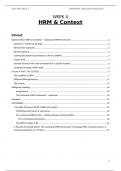2023-2024, Block 2 GW4004MV. Organizational Behaviour
WEEK 4
HRM & Context
Inhoud
Optional video: HRM and Context – Contextual SHRM Framework..................................................................2
Outside-in / Inside-out thinking....................................................................................................................2
Best practice approach.................................................................................................................................2
Best fit approach...........................................................................................................................................3
Contextually Based Human Resource Theory (CBHRT).................................................................................3
4 types of fit..................................................................................................................................................4
Example of how to fill in the framework (for a specific hospital)..................................................................6
Contextual Strategic HRM model..................................................................................................................6
Lecture 4. Part 1 (10-11-2023)..........................................................................................................................9
The evolution of HRM...................................................................................................................................9
Different HRM approaches.........................................................................................................................11
The context.................................................................................................................................................13
Workgroup meeting........................................................................................................................................16
Assignment 4..........................................................................................................................................16
The Contextual SHRM Framework – explained:......................................................................................18
Literature........................................................................................................................................................21
SUMMARIES...................................................................................................................................................22
I. Farndale & Paauwe (2018). SHRM and context........................................................................................22
Predicting performance & well-being.....................................................................................................22
The contextual SHRM model – relation between context & HRM..........................................................22
The 3 contextual mechanisms.............................................................................................................22
The different types of fit.........................................................................................................................24
II. Paauwe & Farndale (2017). The contextual SHRM framework. In Strategy, HRM, and performance: a
contextual approach. (p. 95-106)................................................................................................................25
1
,2023-2024, Block 2 GW4004MV. Organizational Behaviour
Optional video: HRM and Context – Contextual SHRM
Framework
Slide 3. SHRM and context
Many HRM models are developed in for-profit contexts.
But are these also applicable to healthcare (not-for-profit) context?
It is increasingly recognized that context matters for HRM! best fit approach
For example: redesigning self-managing teams in long-term care that also include patients and their
representatives as team members.
Slide 4
Outside-in / Inside-out thinking
Important in the background of strategic management is the evolution of
outside-in/inside-out thinking:
60s/80s: Porter approach, the conduct performance paradigm, in which the
external context (the market) will determine the nature and the
development division of labor and coordination within your
organization.
90s: inside-out approach, also under the influence of the resource based
view of the firm, in which the internal context (your own capabilities, your
own competences) will determine how you are going to manifest yourself in
the external market.
Now: a more balanced approach, where we use both the outside-in as the
inside-out approach. So we look at the external context, but we also look
at our own capabilities; what can we do as an organization, what is
manageable, what can we achieve.
Slide 5. Key hypotheses in SHRM
Also important to be aware of 2 very important hypotheses in SHRM:
Best practice approach (or universalistic approach): from a
normative point of view, a set of HR practices will always
work, under all circumstances.
Best fit approach (or contingency approach): if you are
operating in … such a market, then you would be wise to…
E.g. in a tight labor market, you need to put a lot of effort into your
recruitment, you might to pay a bit higher, and you might need to
do your best in order to become a preferred employer.
Slide 6
Best practice approach
Universalistic ‘best practices’ one size fits all.
Pfeffer’s 7 best practices:
Selective recruitment and selection Communication
Extensive training Reduction of status differences
Performance related pay (PRP) Job security
Teamwork
2
, 2023-2024, Block 2 GW4004MV. Organizational Behaviour
The reason for Pfeffer to label these as the best practices, is because if you apply this in a healthcare setting
in the United States (where all of these aren’t common), then you really would be an exception and do
better than the rest.
If we look at this from western Europe, where we don’t have such huge status differences, where we
already have job security and teamwork, there isn’t much value of these best practice approach.
Slide 7
Best fit approach
Context is important. Then it is important to define what we mean by context…
We distinguish:
Internal context (e.g. configuration) External context
History Market mechanisms
Administrative heritage = the market for your product and services
= how is the organization being shaped from the Institutional mechanisms
past, what was the founding father/mother, has = legislation, collective bargaining agreements, the
there been a merger, etc. norms and values (for justice, fairness, attention to
Culture sustainability, etc.) that are dominant in a society
e.g. is het based on power/hierarchy or is it
more a family culture, etc.
Slide 8. How to reconcile
How can we reconcile these 2 positions?
Best practices are more at the ‘underpinning layer’, so more at the principles layer. E.g. it will always pay
off to select carefully in order to get the best people.
But at the same time you have the ‘surface layer’, which is the nature of the kind of HR tools you are using.
This means that the way in which you recruit and select people will differ per function, per job category, and
so on. E.g. you have a different recruitment strategy for a board position, then for a receptionist position.
Slide 9
Contextually Based Human Resource Theory (CBHRT)
Here you have 3 factors/dimensions, which are determining the context:
1. Product/Market/Technology (PMT) dimension
2. Administrative, organization, and cultural heritage (the internal context) this can be explained by:
you have to give an elevator pitch, in which you are asked to describe your organization to someone in ± a
minute, then you mention a few characteristics: e.g. it has been founded by …, we went through a merger,
now we are in the market for …, etc. So this is a short characterization of how your organization has evolved
from the past and what are its typical characteristics.
3. Social/Cultural/Legal (SCL) dimension
Based on the PMT dimension, you have to be aware of the kind of demands imposed upon you out of the
marketplace; e.g. to be efficient and effective, etc.
3





